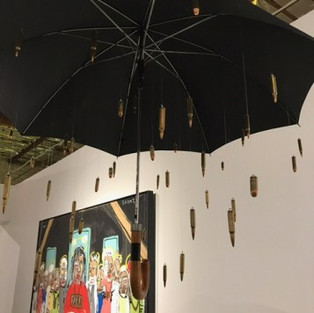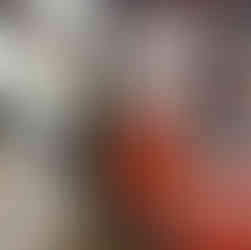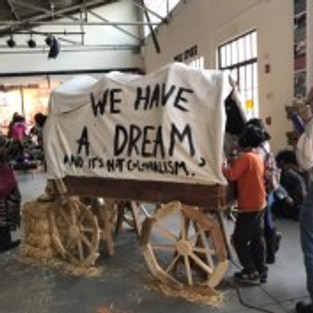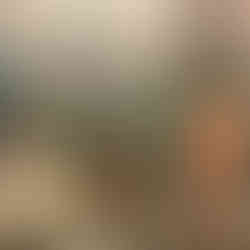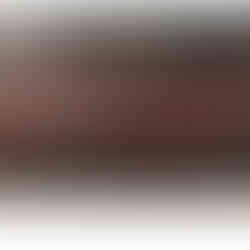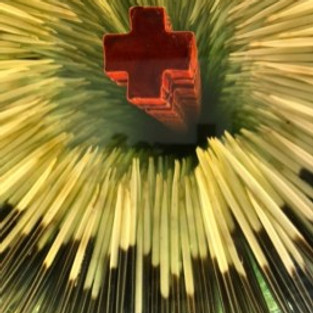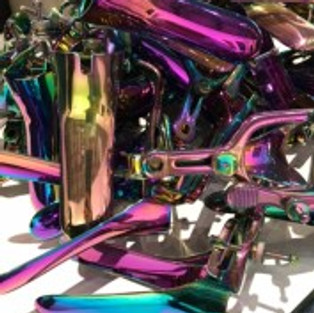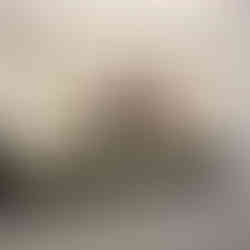
Into Action. Los Angeles. Photo Credit: Genie Davis
Into Action: Art that Brings Power to the People
By Genie Davis The size and portent of “Into Action” are both large-scale. Housed in a north Chinatown former warehouse, it is an exhibition that warns of collective fury: enough is enough and it’s time to take action. Marking the one year anniversary of the first Women’s March and 2017’s presidential inauguration, this is a splashy, stirring exhibition made up of the work of some 150 artists. Assembled by activist organizations and the public relations agency Taskforce, co-curated by artists Glenn Kaino, Favianna Rodriguez, and Hank Willis Thomas, the 9 day exhibition drew crowds to its cavernous space straight through its closing on January 21st.
More than facilitating the belief that art-making is at the core of social change, exhibiting artists included the well-known and the emerging; a vast performance space took over one room in the exhibition space and, across a courtyard, another room was devoted to snacks, poster-making, free poster-taking, and music. This second area was also a lounge for relaxing and conversation, for connecting those who feel passionate about the exhibition’s ideals with others of like-minds. In fact, the thrust of much of “Into Action” is to make contact with current or future activists. To gain admission to the exhibition, visitors were to text the word Artivest to 33222 to enter, and become connected. And within the exhibition, a good number of the works included signage indicating the area of activism being encouraged or depicted, such as “climate,” with the suggestion to text that word to the same number, 33222. Simple, effective connection – possibly the very most powerful element of the exhibition.
The show was designed to be diverse, and it is: a celebration of diverse artistic styles, the jubilance and power of protest, and the wide variety of alternatives to our present social and political traumas.
Entering the exhibition, viewers are struck by a wall covered with news clippings that spill in stacks onto the floor. Darker colored bulletins form the words “what a year” in Derek Gores’ mixed-media piece, an apt summary of both the past 12 months and the work in this show, much vitally current.
Graffiti words produced on a silk banner spell it out on the opposite wall. Sick and Tired by Aubrie Costello adds “of being sick and tired” on the banner to the title of the piece. Trusting, the dark, hauntingly aglow neon wok by Guillermo Bert spells out the reason for this feeling: “Trusting the margin of error was a huge mistake.” Erika Rothenberg recreates an aluminum church sign with plastic letters in a sad depiction of American social life and the American economy in the potent America, The Greatest Nation on Earth. Jillian Kogan’s assemblage, California Resistance recreates California’s state bear in a mosaic of pills. Using gold leaf and spray paint, Empathy 2 creates a dazzling, bitter Saber, a stunning version of the American flag. A vast, suspended, broken version of the flag takes up a large corner of the first room of the exhibition, with the names of companies like IBM and Boeing in the mix of pieces that also includes images of bullets, missiles, and battleships. Iconic works by Shepard Fairey appear several times in the exhibition, including Paradise Turns, a silkscreen on wood panel work showing a stylized couple under a beach umbrella, oil derricks ominously in the background, with the caption “Paradise until the tide turns.” Indeed.
The works in the show proceed in sections through a variety of topics: the election, pollution and climate change, gun control, police violence, the Black Lives Matter movement, healthcare, and feminism, among them.
Some of the strongest works include Mear One’s elaborately detailed vision of Revolution, Patrick Martinez’ neon Electoral College, and Cara Levine’s haunting beige sculptures This is Not a Gun. Her works pay tribute to individuals killed for carrying items mistaken for weapons, from a flashlight to an iPod. Chip Southworth’s oil enamel on birch panel works read, in bold colors “I was Holding a Toy” and “I Was Wearing a Hoodie,” both referencing instances in which persons of color were murdered by the police or a self-styled vigilante. A delicate, raindrop-like suspension of bullets hangs from monofilament beneath a black umbrella in Michele Pred’s Security Storm, while bullet shells are connected by a maze of thread in Lisa C. Soto’s The Shortest Distance Between Two Points.
Holly Ballard Martz’ In Utero (Study for Installation) gives us a steel wire and wire coat-hangar wall sculpture that is both graceful and painful to comprehend. Rainbow coated speculums dazzle into a dimensional sculpture by Zoe Buckman in Rainbow Speculums. Two absolutely stunning mirror wall sculptures by Tim Tate may be among the most fascinating works in the show – The Moment uses mirror, LEDS, ceramic, and porcupine quills to shape a dimensional work that seems to go on forever, paired with the mirrored, dimensional We Rose Up. Both pieces feature a red cross at center, and both refer to the quest for decent healthcare in the U.S. Christine Won Yap’s Forward is one of the most hopeful works in the show, wood type on ribbon, linen, and thread, the piece reads “Forward out of Darkness Leave behind the night, forward out of error, forward into light.”
Many of the works here feature the use of words as well as purely visual images or in adjunct to them. It is interesting that overall the exhibition exudes urgency, the need to “say” so much that it must be literally “said” in words as well as in images. A personal favorite is Micehle Pred’s collection of neon words on handbags, which illuminated off and on, “Me too,” “Time’s Up,” and “Vote,” and “Persist” among them. Mary Iverson’s acrylics on found-photographs are among the few diminutive pieces in the show, a series of nude figures placed in arcane settings, “#WhatNow.”

Into Action. Los Angeles. Photo Credit Genie Davis
As the exhibition space draws viewers into the stage/performance room, Jeremy Dean’s Everything that Rises, a circular sculpture of 16 folding chairs, suggests activism, while within the performance space, a statue by Carole A. Feurman offers a lacquer on bronze female Buddha Durga Maa, which suggests contemplation and meditation.
The sound of plates shattering echoed throughout the exhibition, creating a sense of discord and urgency. Visitors who wished to do so could enter a separate small room, don goggles, and smash plates of various sizes – the sizing representing ideas such as Patriarchy and Disobey.
Across the courtyard in the lounge/dining/poster-making area, hanging from the back of a small Conestoga wagon, are these words “We believe that people should not live or die from poverty in the richest nation ever to exist.”
We believe lots of profound things – the question that this almost overwhelming, large-scale, provocative installation asks is – can we put our beliefs “Into Action”.
#california #losangelesartist #santamonica #art #painting #beverlyhills #westhollywood #contemporaryart #southerncalifornia #abstract #collage #feminist #photography #artgallery #culvercity #museum #artandcake #artopening #assemblage #artexhibition #ArtandCakeLA #artists #artist #soloshow #mixedmedia #arts #environment #artreview #sculpture #artmagazine #ArtandCulture #exhibition #exhibit #drawing




